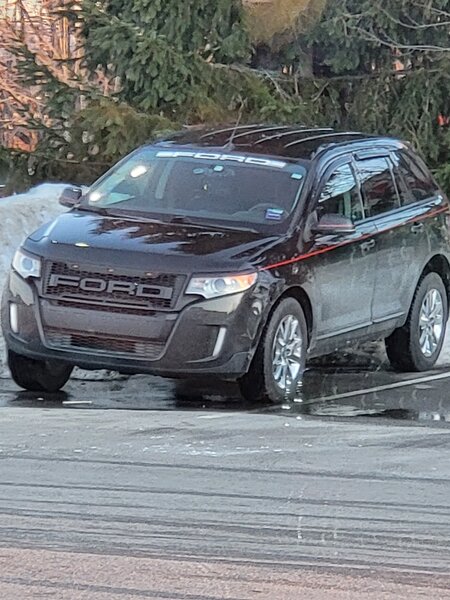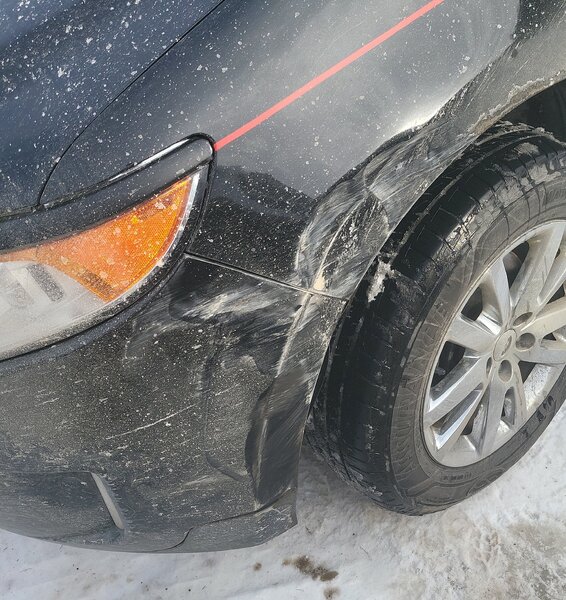-
Images
-
Popular Contributors
-
Posts
-
Welcome. If you're not a DIY person and reliant on service shops, then search for a reputable shop because the mechanic you've been using is obviously not qualified and throwing parts at it. When you say that it struggles going uphill - is the engine revving high but not changing up to the next gear - the engine revving high should deliver more power until it reaches maximum revs - maybe a video of what's happening will give us a better idea. Get the stored fault codes read and post them here.
-
Welcome to the Forum @mdk1016! From the 2011 Edge Workshop Manual... Rear Suspension Torque Specifications Description Nm lb-ft lb-in Lower arm cam adjuster nut 150 111 — Lower arm outboard nut 175 129 — Parking brake cable bolt 18 — 159 Shock absorber lower nut 225 166 — Shock absorber upper nut 25 18 — Stabilizer bar bracket nut 55 41 — Stabilizer bar link upper and lower nut 40 30 — Toe link inboard nut 200 148 — Toe link outboard nut 175 129 — Upper arm inboard nut 175 129 — Upper arm outboard bolts 175 129 — Wheel hub and bearing bolt 115 85 — Wheel hub nuta — — — Trailing arm bracket-to-frame bolts 48 35 — Trailing arm nut 150 111 — Wheel knuckle-to-trailing arm nuts 103 76 — Wheel speed sensor bolt 7 — 62 Rear Drive Axle/Differential Torque Specifications Description Nm lb-ft Differential housing cover bolts 23 17 Differential housing-to-front insulator bracket bolts 90 66 Filler plug 29 21 Front insulator bracket-to-subframe bolts 90 66 Pinion flange nut 244 180 Rear driveshaft U-joint flange bolts 70 52 Side insulator bracket-to-rear axle differential bolts 90 66 AWD vehicles NOTICE: Do not tighten the rear wheel hub nut with the vehicle on the ground. Tighten the wheel hub nut to specification before the vehicle is lowered to the ground. Wheel bearing damage occurs if the wheel bearing is loaded with the weight of the vehicle applied. NOTE: Apply the brake to keep the halfshaft from rotating. Position the halfshaft in the wheel hub and bearing assembly and use the previously removed wheel hub nut to seat the halfshaft. Tighten to 350 Nm (258 lb-ft). Remove and discard the wheel hub nut. NOTICE: Install and tighten the new wheel hub nut to specification within 5 minutes of starting it on the threads. Always install a new wheel hub nut after loosening, or when not tightening within the specified time, or damage to the components may occur. Install a new wheel hub nut. Tighten to 350 Nm (258 lb-ft). Good luck!
-
Hello all. Never had so much trouble trying to find torque specs like this lol. Hoping someone can help me out here. I have a 2011 Ford Edge AWD with the 3.5l motor. I am looking for the following torque specs for the knuckle and hub assembly area. Shock Absorber Lower Bolt to the knuckle: Hub Assembly: Lower Control Arm Nut and the smaller bolt that connect the knuckle: Upper Control Arm to the knuckle: Lateral Arm to the knuckle: Trailing Arm for the four bolts to the knuckle: Axle nut:
-
TECHNICAL SERVICE BULLETIN Misfire With DTC(s) P0301, P0302, P0303, And/Or P0304 Stored In The PCM 25-2074 06 March 2025 This bulletin supersedes 24-2384. Reason for update: vehicle models affected Model: Ford 2025 Bronco Engine: 2.3L EcoBoost 2023-2025 Escape Engine: 1.5L EcoBoost Engine: 2.0L EcoBoost 2025 Explorer Engine: 2.3L EcoBoost 2024-2025 Mustang Engine: 2.3L EcoBoost 2025 Ranger Engine: 2.3L EcoBoost Lincoln 2023-2025 Corsair Engine: 2.0L EcoBoost 2024-2025 Nautilus Engine: 2.0L EcoBoost Engine: 2.0L EcoBoost Hybrid Markets: North American markets only Issue: Some of the vehicles listed in the Model statement above may exhibit an engine misfire condition with DTCs P0301, P0302, P0303 and/or P0304 set in the PCM. Action: For vehicles that meet all of the criteria in the Issue and Model statements, follow the Service Procedure to diagnose the vehicle. Warranty Status: Information Only. Repair/Claim Coding Causal Part: IN Condition Code: -1 Service Procedure NOTE: This article is for information only. Determine the causal part number and use available labor times in the SLTS Manual or claim M-time in accordance with the Warranty and Policy Manual, do not use this article number as the M-Time labor operation. Causal part number IN in this article refers to the information only status and is not able to be claimed. 1. Remove and inspect the condition of all spark plugs. Refer to the WSM, Section 303-07. Are any spark plugs damaged? (1). Yes - proceed to Step 2. (2). No - this article does not apply, replacement of the spark plugs is not necessary, proceed with normal diagnostics found in the WSM. 2. Inspect the 12v battery positive and negative terminals for a loose condition, refer to WSM, Section 414-01 and repair as necessary. 3. Inspect all PCM ground circuitry for loose connections and/or high resistance and repair as necessary. 4. Use a borescope to inspect the condition of the affected pistons and cylinder walls. Refer to Figures 1-3 for examples of normal cylinder wall wear and Figures 4-5 for examples of damaged cylinder walls. Additional examples of engine wear can be found in the Engine Failure Analysis GSB > Cylinder Wall and Piston Skirt Inspection. Do the pistons and/or cylinder walls appear to be damaged? Figure 1 - Showing normal cylinder wall wear Figure 2 - Showing normal cylinder wall wear Figure 3 - Showing normal cylinder wall wear Figure 4 - Showing a damaged cylinder wall Figure 5 - Showing a damaged cylinder wall (1). Yes - remove the cylinder head to perform a more detailed inspection of the suspect damage. Refer to the Engine Failure Analysis GSB > Cylinder Wall and Piston Skirt Inspection and repair as necessary. For cylinder head removal, refer to the WSM, Section 303-01. (2). No - perform a compression test and cylinder leakage test following WSM, Section 303-00 and repair as necessary. 5. Replace all damaged spark plugs. Do not discard the damaged spark plugs so Ford can retrieve them following the warranty parts return process. 6. Submit a GCR and include photos of damaged components, images from the borescope analysis and anything else of interest that was found during the repair. These images will help improve engine quality for future model vehicles. (1). Do not use the Report A Problem link to submit the GCR. © 2025 Ford Motor Company All rights reserved. NOTE: The information in Technical Service Bulletins is intended for use by trained, professional technicians with the knowledge, tools, and equipment to do the job properly and safely. It informs these technicians of conditions that may occur on some vehicles, or provides information that could assist in proper vehicle service. The procedures should not be performed by "do-it-yourselfers". Do not assume that a condition described affects your car or truck. Contact a Ford or Lincoln dealership to determine whether the Bulletin applies to your vehicle. Warranty Policy and Extended Service Plan documentation determine Warranty and/or Extended Service Plan coverage unless stated otherwise in the TSB article. The information in this Technical Service Bulletin (TSB) was current at the time of printing. Ford Motor Company reserves the right to supersede this information with updates. The most recent information is available through Ford Motor Company's on-line technical resources. TSB 25-2074 - Misfire With DTCs P0301, P0302, P0303, And-Or P0304 Stored In The PCM - 03-06-2025.pdf
-
Hi everyone, I have a 2018 Ford Edge 2.0 SEL AWD with around 240,000 km. About a year ago, it started having acceleration issues. Since then, I’ve taken it to the mechanic multiple times and replaced the following parts: • Spark plugs • Timing set • Solenoids • Turbo • Catalytic converter Basically, almost everything has been replaced, but unfortunately, the problem still persists. The car struggles especially when going uphill — it revs loudly but never goes over 80–90 km/h. Has anyone experienced something similar? Could this be a transmission issue? Any advice would be greatly appreciated.
-
I gave up on the Ford parts, both original and updated. I use TOGGLER TC wall anchors. I cut off enough of the vertical fins, that help grab drywall, to allow the toggle to go through a 3/8 inch fender washer. I hot glued 1" OD x 1/2" tall x 1/2" ID nylon spacers (McMaster #94639A876) to the inside of the covers. I inserted the toggler where the old Ford part was and then used the toggler tool to set the toggle. I did this two years ago and all are sill holding strong.
-
I have an aspirated 3.5. 7.5k is the recommended interval, although I usually add a quart around 6k miles.
-
@chr8990 My schedule is much the same. • Oil - Full Synthetic (5k) - same • Brake Fluid (40K) - 2 years • Transmission Flush (30K) - 45K • Coolant Flush (45K) - 2 to 3 years • Spark Plug replacement/Tune Up (45K) - same • PTU (30K) - same • RDU (30K - same time as PTU) - same • I have a catch can on mine - I have the same JLT catch can
-
This is my maintenance schedule: • Oil - Full Synthetic (5k) • Brake Fluid (40K) • Transmission Flush (30K) • Coolant Flush (45K) • Spark Plug replacement/Tune Up (45K) • PTU (30K) • RDU (30K - same time as PTU) • I have a catch can on mine: https://www.jlosc.com/jl-3-0-oil-separator-passenger-side-2015-2020-edge-sport-st-lincoln-mkx-2-7l-ecoboost/ • I'll still have the dealer do a The Works Plus Package that includes a treatment of BG 44K once every 3 oil changes
-
@Przemo I replaced those fasteners on my 2017 Sport and after a few months the rattle was back.
-
-
Topics









